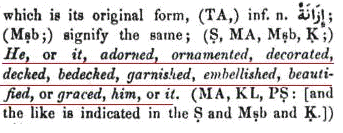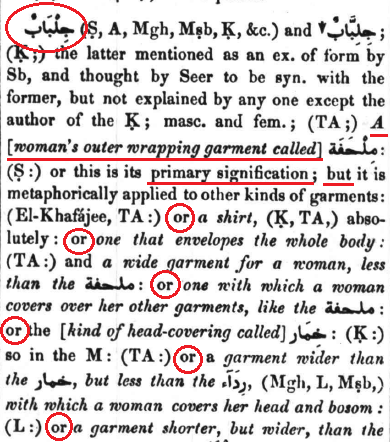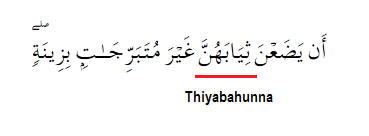
The articles on this website may be reproduced freely as long as the following source reference is provided: Joseph A Islam www.quransmessage.com

Salamun Alaikum (Peace be upon you)

The articles on this website may be reproduced freely as long as the following source reference is provided: Joseph A Islam www.quransmessage.com

Salamun Alaikum (Peace be upon you)
HIJAAB
![]()
Copyright © 2009 Joseph A Islam: Article last modified 25th July 2012
First and foremost, the Quran does not make use of the word ‘Hijaab’ to address the covering of the head or hair.
However, it has been used as follows:
· To signify the veil between the companions of the garden and the companions of the fire (7:46)
· The veil of partition between those who do not believe in the hereafter (17:45)
· The separation / seclusion / screen Mary introduced between herself and her people (19:17)
· In reference to Prophet Solomon (pbuh) and in relation to the narrative with regards his horses (38:32)
· To signify the debarring that the transgressors will experience from their Lord on the Day of Judgement (83:15)
· To signify the separation of the Prophet's wives - See section below (33:53)
· The claim of the disbelievers to signify the veil between what they believe and what the Prophet is calling them to (41.5)
· The veil that God uses to speak to mankind (42:51)
Let us take a look at the stipulations and guidance that has been advanced by the Quran with regards to covering with a view to understand the directives better.
The first directive is to the
man and then to the woman in the following context.
024.030
“Say to the
believing men
that they should lower their gaze and guard their modesty: that will make for
greater purity for them: And God is well acquainted with all that they do”
024.031
“And say to the believing women that they should lower their gaze and guard
their modesty; that they should not display their
What should be immediately apparent is the
specific directive to cover the chest for women. It would be apt here to note some of the Arabic terms in a little more depth.

Four considerations must be made to understand this verse better with regards to the Arabic terms used. Please note that use has been made of the most reliable and earliest classical Arabic lexicons to understand the terms as understood by the classical scholars.
(1) What constitutes Zeenatahunna?
(2) What constitutes Bi'khumurihinna?
(3) What is the meaning of 'Jayubihinna'?
(4) What is the meaning of ‘Ila ma zahara minha’?
(1) WHAT CONSTITUTES ZEENATAHUNNA?
not to display this beauty and adornment to those other than the people listed in verse 24:31.An understanding of the root word ‘ZAY-YA-NUN’ (from zeenatahunna) clearly indicates that this is a reference to make-up, beautifying oneself, adorn to an extent which can become a cause of attraction. The directive is

Source: Edward Lanes Lexicon [1]
(2) WHAT CONSTITUTES BI'KHUMURIHINNA?
A 'Khumur' (plural) denotes a covering for both men and women (Khimar).
(
Please see related article [1] below)
The injunction to draw the 'khimar' with a view to cover the breasts does
not necessarily relate to the use of the khimar but the focus is to make it clear that a woman’s breasts are not included in the concept of ‘What may decently be apparent’ of her body and therefore should not be displayed.

Source: Edward Lanes Lexicon [2]

Source: Edward Lanes Lexicon [3]
(3) WHAT IS THE MEANING OF JAYUBIHINNA?
or the bosom, heart or even a place or entrance for a land or country. There is no relationship with women's hair coverage within the meaning of the word.The meaning of the word 'Jayubunna' is well known to both modern and classical Arabs. Its root is 'JIM-YA-BA' and has always been used to signify an opening of a shirt or sleeve or a pocket

Source: Edward Lanes Lexicon [4]
(4) WHAT MAY BE DECENTLY APPARENT (Ila ma zahara minha)
‘Ila ma zahara minha’ is a reference to what a person may openly reveal in accordance with prevailing custom which is decent and not unduly immoral. However, traditional clergy have throughout Islamic history attempted to restrict the definition of ‘what may decently be apparent’ to a woman's hands, feet and her face, and at times, even commanding full coverage.
However, from analysis, it appears that the meaning of ‘Ila ma zahara minha’ has a much wider purport. It's subtlety and deliberate ambiguity in the Quranic narrative (as God never runs out of words 18:109) seems to allow for all society norms and sensible judgment which remains firmly within the ambit of 'human decency'.
A possible cue to understand this phrase is verse 24:60 where by deduction, a younger believing woman is expected to maintain an outer garment covering (thobe) when in unfamiliar company. The classical definition of a woman's thobe as an outer garment is understood to provide coverage of the arms and legs, leaving exposed the feet, hands, face, head and neck. Please see section 'COVERAGE OF THE ARMS AND LEGS' below. Bedecking the hair in public (beautifying oneself to an extent which can become a cause of attraction) also needs to be carefully considered under the broad Arabic term 'zeenat'.
THE HIJAAB (PARTITION) IS ONLY A DIRECTIVE FOR THE PROPHET’S WIVES
(i) The Prophet’s wives are not like other women
033.32-33
"O wives of the Prophet! you are not like any other of the women; If you will be on your guard, then be not soft in (your) speech, less he in whose heart is a disease yearn; and speak a good word. And stay in your houses and do not display your finery like the displaying of the ignorance of old; and keep up prayer, and pay the poor-rate, and obey God and His Messenger. God only desires to keep away the uncleanness from you, O people of the House! and to purify you a (thorough) purifying"
(ii) Prophet's wives have the potential to receive twice the punishment of normal wives
033.030
"O wives of the prophet! whoever of you commits an open indecency, the punishment shall be
increased to her doubly; and this is easy for God"
(iii) Prophet's wives have the potential to receive twice the reward of normal wives
033.031
"But any of you that is devout in the service of God and His Messenger, and works righteousness,
to her We shall grant her reward twice: and We have prepared for her a generous sustenance"
was indeed righteous (66:11).
Note: It is clear from the above narrative that by virtue of being the wife of a Prophet does not make her automatically righteous. From the Quran it is clear that both Noah’s and Lot’s wives were NOT righteous (66:10), however Pharaoh’s wife
(Please see related article [2] below)
(iv) They cannot re-marry
033.053
"....Nor is it right for you that you should annoy God's Messenger, or that you should marry his widows after him at any time. Truly such a thing is in God's sight an enormity"
(v) The Prophet’s wives are like the mothers of the believers
This is an elective spiritual relationship of the highest degree, the wives of the prophets are to be seen in a similar spiritual relationship or capacity as one's own mother. The respect and kindness offered to them must also be of a similar status.
Having established the principle that the wives of the Prophet were
not like other women, it becomes obvious that the directive to screen (Hijaab) is only a directive to the Prophet’s wives and given the text.
033.053
Such (behaviour) annoys the Prophet: he is ashamed to dismiss you, but God is not ashamed (to tell you) the truth. And when you ask (his ladies) for anything you want, ask them from behind a partition (Arabic: Hijaab): that makes for greater purity for your hearts and for theirs. Nor is it right for you that you should annoy God's Messenger, or that you should marry his widows after him at any time. Truly such a thing is in God's sight an enormity”
“O you who believe! Enter not the Prophet's houses,- until leave is given you for a meal, (and then) not (so early as) to wait for its preparation: but when you are invited, enter; and when you have taken your meal, disperse, without seeking familiar talk.
As can be seen, the above verse regarding ‘Hijaab’ is
not a reference to the hair and the 'screening' only applies to the Prophet’s wives. When directives are intended to include other women, apart from the prophet's wives, the Quran clearly addresses them. This can be seen in the next verse (33:59).
WEAR A 'JILBAB' BUT BE RECOGNIZABLE
(Arabic: Yudnina) over them their outer garment (Arabic: jalabibihin): that is most convenient, that they should be recognized (Arabic: Yu'rafna) and not given trouble. And God is Oft-Forgiving, Most Merciful.”033.059
“O Prophet! Tell thy wives and daughters, and the believing women, that they should bring down

Firstly, it is important to note that the purpose of wearing an outer garment (jalbab) is to provide an extra layer of modesty so that women are not harassed in any way. However, women should also remain discernable
(Arabic: Yurafna). A full body coverage which covers the face would clearly contradict the requirement of being recognized, known or discernable (Yurafna).
Secondly, many commentators give many differing and often unnecessarily elaborate renderings of what constitutes a 'Jalbab' (from Jalabibihinna). The primary signification of this term has usually applied to a woman's outer wrapping garment. However, this term is
metaphorically applied to all manner of other kinds of garments, which include shirts, wide garments, khimar, full body cover etc.

Source: Edward Lanes Lexicon [5]
The Arabic phrase 'Yudnina alayhinna' has been used in conjunction with 'jalabibihinna'. 'Yudnina' comes from the verb 'adna' which primarily means to draw something closer or to bring near, which in the context of 33:59 would be a reference to the garb. Some translators argue an implication of 'letting down', or 'drawing lower' of the garb which would imply the 'jilbab' to be draped over the body towards the feet rather than a covering of the hair. However, it is to be appreciated that this is not a literal translation but one better understood as an interpretation.
In summary, the above verse 33:59 simply connects and confirms the directive in Surah Nur (24) verse 31 regarding covering to remain modest.
COVERAGE OF THE ARMS AND LEGS
suitable garment. A 'thobe' was a garb of the classical Arabs (and worn today) which provided such a coverage. The Arabic word 'thobe' is singular of the word 'thiyaab' and means something that is worn as a garment. It can be a normal garment and an outer garment. (11:5; 24:58). A 'thobe' is primarily a garment or robe worn by men but when applied to women (classically), it is usually referred to as a long gown reaching to the feet with wide sleeves. It is usually worn over other garments when it applies to women.
There is a clear expectation from the Quran that women will have their arms and legs covered by the wearing of a


Source: Edward Lanes Lexicon [1]
In verse 24:60, we clearly note that an older woman is permitted to
remove this 'thobe' without wanton display of their beauty. This cannot refer to her normal garments as if this were to be removed she would be left exposed.
Hence, there is an inherent expectation that younger women will continue to wear an outer garment such as a 'thobe' that covers their arms and legs up to their feet.
024.060
"Such elderly women as are past the prospect of marriage, there is no blame
on them if they lay aside their (outer) garments
(Arabic: Thiyabahunna),
provided they do not display their beauty / adornment. But it is best for
them to modestly refrain: and God is One Who sees and knows all things"

Today, it is still a reference to a type of long draping garment worn by many Arabs, especially men (thobe, dishdasha etc).
For a deeper look at the relationship between the two Arabic terms 'thobe' and 'jilbab', please see article [3] below which provides comprehensive lexicon references and an illustration.
THE GARMENT OF PIETY IS THE BEST GARMENT
Having discussed some of the technical aspects of the terms and their usage one must not lose sight of the overarching directive of the message and the Quran’s philosophy at core. That is, that the garment of purity is most important. Piety radiates from one's heart and one's garments are of no use if the heart is not pure.
007.026
"O ye Children of Adam! We have bestowed clothing upon you to cover your shame, as well as to be an adornment to you. But the raiment of righteousness,- that is the best. Such are among the Signs of God, that they may receive admonition!"
![]()
FINAL THOUGHTS
The above discussion should facilitate a better understanding of the Quran’s directives. There is no specific reference to covering of the hair and the Arabic word 'Hijaab' has never been used to signify nor even insinuate this. However, if an individual feels that their particular covering lends to better modesty (including hair and face covering) and with respect to prevailing customs, then this is their prerogative. One needs to be careful however not to override the Quran’s injunctions with a view to favour or seek overtly liberalist positions and also not to present overtly repressive directives when they are not decreed by scripture.
However, one can argue that bedecking the hair in public (beautifying oneself to an extent which can become a cause of attraction) needs to be carefully considered under the broad Arabic term 'zeenat'. This is indeed a subjective area and I remain non committal to define 'zeenat' as I do not see any reason to when the Quran has not explicitly done so. Many may feel that such bedecking would fall under the scope of 'zeenat'. If so, the directive is not to display this beauty and adornment to those other than the people listed in verse 24:31. (See section 1)
The basic directives have been clearly laid out by the Quran with regards to what is expected and this should be understood and not transgressed.
Related Articles:
(1) A Deeper Look at the Word 'Khimar'
(2) Appeal to Righteousness Based on Lineage, Relationship, Companionship and Proximity
(3) Thobe & Jilbab
REFERENCES
[1] LANE. E.W, Edward Lanes Lexicon, Williams and Norgate 1863; Librairie du Liban Beirut-Lebanon 1968, Volume 3, Page 1279
Highlights marked in red on the lexicon excerpt are my own insertions. They have no bearing on the original text other than they emphasise relevance to the topic at hand. These are merely illustrations and have solely been utilised for educational and explanatory purposes.
[2] Ibid., Volume 2, Page 809
[3] Ibid.
[4] Ibid., Pages 492-93
[5] Ibid. Page 440